A DEEP & DIVINE DEVI CONNECTION
PART 02
KM: Wow, you even had an alibi to these visions. Did you ever talk to Swami about these things that you saw?
MN: No, never. But I did tell Him about my wish to see Devi Swarup or the form of the divine Goddess. When I mentioned this to Swami,
He looked straight into my eyes and said, “Can you see with these eyes?” I didn’t understand Him then. He then said, “I will give you the vision.” When Swami says something, we don’t ever know when He would make it happen. He also advised me to focus on any one name of the Goddess from the Sahasranama that appealed to me the most and dwell on its glory and sweetness. I also wanted His permission to do the Lalita Sahasranama Laksharchana (an elaborate ritual to appease the feminine aspect of divinity). My husband was totally against the idea, because I had a back problem and was not supposed to sit down. The Laksharchana would take 8 to 9 hours of sitting down every day for 10-12 days. So, my husband said that if I ever started the pooja, he would call the ambulance and just walk out of the house. He said I should be ready to face whatever happens. I took the courage and decided to consult Swami about it. The next time I was with Swami in the interview room, I said, “Swami I want to do Laksharchana.” Immediately, He said, “Did you take his (husband’s) permission?”
SSN: I am going to interrupt here and give you the real picture. My wife and I had had a number of conversations about her wish to conduct a Laksharchana for the second time. The first time she did the pooja was when she was younger and healthier, so she had no problems then. As you would know, Laksharchana is very, very strenuous where you have to do about 20 - 25 Lalita Sahasranama (each Sahasranama has a 1008 names of the Goddess) cycles every day, which meant about eight to nine hours of pooja daily. It’s an elaborate ritual. Now, when she was insisting on doing it for the second time, she was already going through severe back problem. I tried to persuade her against the idea in her present state of health. Finally, I gave up convincing her and asked her to ask Swami and if He agreed, then we would go ahead with the pooja.
A few days after this conversation, we got an interview call from Swami. The minute she asked Him the question (about performing the elaborate pooja), Swami without batting an eye lid said, “You have to take your husband’s permission.”
A few days after this conversation, we got an interview call from Swami. The minute she asked Him the question (about performing the elaborate pooja), Swami without batting an eye lid said, “You have to take your husband’s permission.”
When Swami said that, He saw us exchange looks and asked, “What happened? Tell me?” I caught hold of Swami’s feet and said, “Swami, I would love for her to do the pooja but her state of health doesn’t permit. I have been telling her not to do it at this time. I seek your blessing for that.” Swami then looked at her and said, “See what he says? You need to listen to him.” The message that Swami conveys, and the way he conveys that message is so tactful.
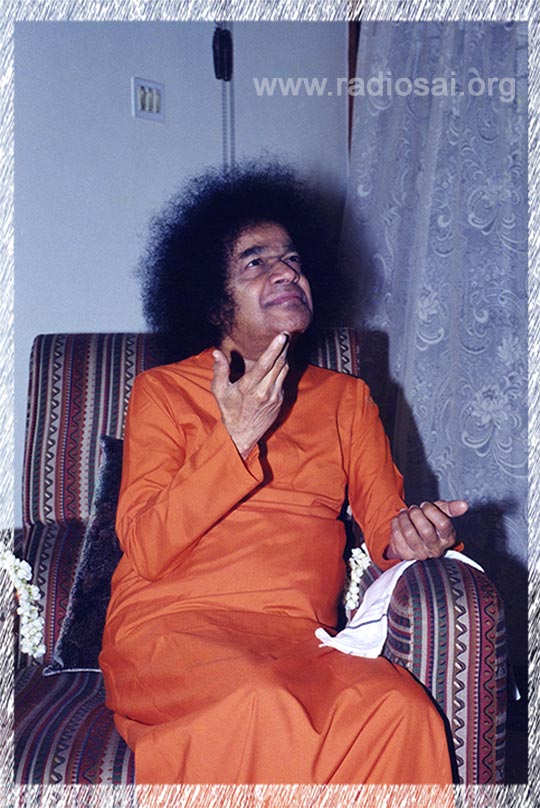 |
He does it so beautifully that you don’t realize He has just given you the profound insight that a lot of decisions in married life need to be taken by mutual consent. That was the real message He gave us that day.
MN: So, after this conversation, we went to the Vaishnodevi Temple in the summer holidays. I couldn’t climb the steps and had to be taken up in the palanquin. Throughout the journey, I was reading the Lalitasaharanamam and its meaning until we reached the top of the hill. My only prayer was my wish to do this pooja. I kept talking to God saying, “When I am not physically fit, how will you get this done, I leave it to you.” Somehow, in just four days after returning from the temple, I started doing all the preparations for the pooja, and arranged for the priest. The only thing I hadn’t gained was my husband’s permission. But I still went ahead as Baba had given me this permission. It was an 11-day pooja, with some 12,000 archanas in a day. We did the Laksharchana for nearly one lakh and twenty five thousand cycles. On the last day, we did the Poornahuthi.
It was very intense, for some five hours in the morning and four hours in the evening. I must also tell you that during that interview with Swami when I was seeking His permission, I had told Him that I wanted to see Devi Swaroopa – Durga Maa in her full form
He then looked back at me for a long time without blinking and asked, “Can you see God with these eyes?” He said, “I will give you drishti” or a special vision or capability for beholding the divine Mother.
Swami’s words were on my mind but I never thought about it when I was doing this 'havan'. On the last day of the Laksharchana, when I was sitting and watching the homa kunda (the pit of the sacrificial fire) that was about three feet tall, I suddenly saw Goddess Durga sitting on the lion. And with each 'aahuti' (offering) that my husband was putting into the fire, Goddess Durga’s tongue would come out and take the 'aahuti' and go back in. For a minute, I was in a state of shock. I couldn’t believe what I was seeing. But then after a while, I really started enjoying the fact that whatever was being offered to Devi was indeed being accepted.
Only I could see her. She was in the Simhavahini form. She was seated peacefully on a lion, on the edge of the bricks of the homa kunda (the pit for the sacrificial fire). Only the tongue came out to take in the aahuti (offering) and would go back. The whole image was about three feet.
I can't explain what I felt. And that particular day, before the 'havan' started, I could literally feel the presence of God in the house. Every day, after the pooja (prayers) we would shut the room and open it early in the morning at 4 o' clock to start preparations. That particular day, I felt there was somebody inside. I was a little scared to open the door. I just called my husband, made some noise to shoo whatever was inside and then opened the door. I was probably not ready for that particular moment.
KM: Perhaps you might have seen her in the morning itself, in the pooja room.
MN: Yes, I regret why I felt so scared. But of course it was a different experience altogether of seeing her in the homa kunda (the sacrificial fire pit). It was bliss, something so divine. You could feel God's presence everywhere.
KM: Did you ever talk to Swami about it?
MN: No, I never thought of doing that.
KM: It was enough that your heart's desire had been fulfilled. You are a huge Devi Bhakta, aren't you?
MN: I love the form of Devi Durga.
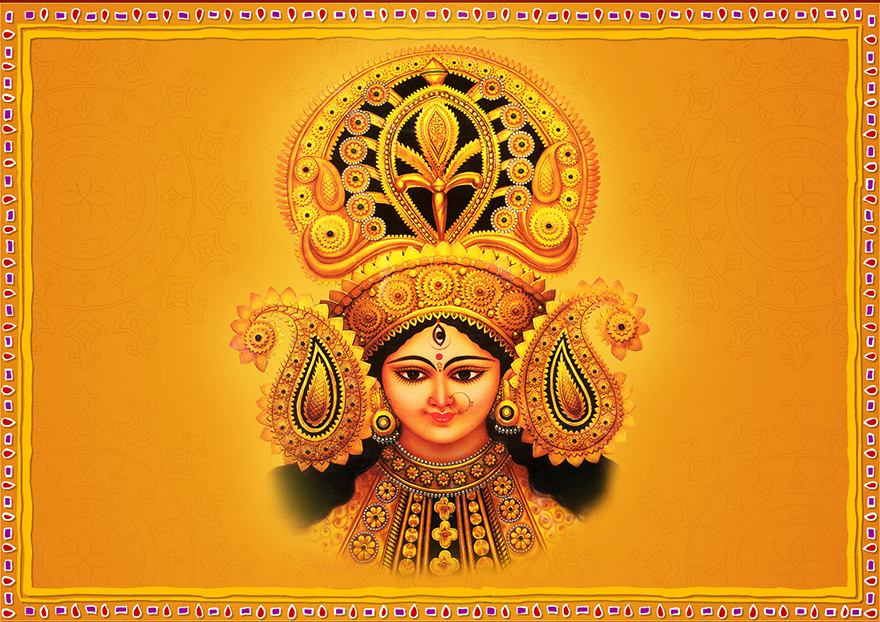 |
Photo Courtesy: durgamaa.wordpress.com
|
KM: I have heard people go to Vaishnodevi praying for a son or getting their daughter married. You seem to be the rare person who went up all the way to Vaishnodevi chanting Lalitasahasranama to seek permission to do the pooja.
MN: I went up reading each word and knowing what it meant. My only prayer was that someday I would be able to do the pooja and my health would allow me to fulfil this long time wish. And, I am glad that everything went on so well. The pooja gives you the energy. It is only Devi’s grace that gives you the shakti to complete one lakh twenty five thousand (1,25,000) cycles of the archana.
KM: Thank you so much for sharing this incredible experience. I haven't heard anything like this before. Now coming to something more ladies can relate to - I understand Swami expected you to nearly dress like the Devi. Could you tell us how Swami insisted that you wear colourful zari saris?
MN: Puttaparthi being a warm place, I decided to buy some cotton saris as it was not comfortable to wear silks all the time. So, I bought those cream coloured Kerala saris with a gold border. On that particular day, I was wearing this sari when Swami called us in for an interview. I opened the door and had not even stepped in when He looked at me and said, “Chi, what sari are you wearing?” His first word 'Chi' made me really cower and wonder what I had done wrong!
When He asked me what sari I was wearing, I said it was a Kerala sari. He asked if I was from Kerala. I said, no. Then He replied, “This is not good.” He would always tell me to wear colourful saris with big zari borders.
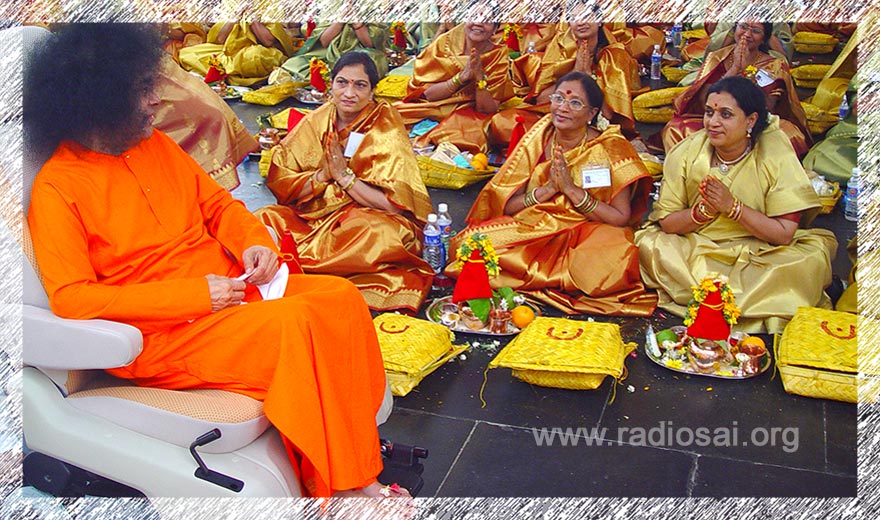 |
On another occasion, I had just been discharged from the hospital after being treated for dehydration and was feeling very tired. I told my husband that we would go for Baba’s darshan early next morning. That day, I wore whatever came to hand and because Swami had said no cotton, I reached out for a silk sari. Swami called us again for an interview and gave me a top to toe look.
I was wearing a silk sari without any zari (gold work). So Swami said, “What saris you wear, no zari?”
Swami would be particular even about the earring you wear. As I said, during this interview, I was wearing a simple silk sari with no zari border. And I was also wearing a small earring because I had just come back from the hospital and didn’t have the time to change. Swami noticed even that. He said, “What is that ear ring, I can't see anything. So tiny!” Such was the level of detail that He noticed.
During one of our long stays in Puttaparthi, I was just about to have lunch in the canteen when someone came up to me and said Swami was calling me. I was shocked because I was wearing salwar kameez (Punjabi suit) then. Swami's car was already parked below with the door open. Mr. Padmanabhan was sitting there. I was so scared to face Swami in a salwar kameez that I wondered whether I should go to Shanti Bhavan where I was staying and change or whether I should go in the salwar kameez. I decided that it was not proper to make God wait and so I sat in the car – all the way I was muttering to myself out of nervousness and chanting Sairam Sairam. Mr. Padmanabhan must have thought I had gone crazy.
I went to Poorna Chandra Auditorium and through the stage back door, Mr. Padmanabhan took me to His house. All the time I was trying to adjust my dupatta (similar to shawl) making it look like something long and flowing. Swami was sitting far off looking at me enter. He laughed and said, “Come come. Don't you wear this at home?” I said, “Yes Swami, I wear this at home.” He said, “Then this is your house.”
He made me feel at home, put all my tensions to ease. That was Swami - the Mother Sai interacting with His children.
In the early days, Swami used to spend a lot of time in Brindavan (Bangalore). And I would go for His darshan every day. Swami would come very early, at about 6.45 and the darshan would be over by 7.15 or so. To reach on time, I would have to leave home at 5 o’clock, reach Whitefield at 6 AM and in half or hour or 45 minutes, Swami would come out. This was a pattern every day. My husband once got annoyed and said, “You don’t have to go see Swami every day!” He didn’t like that I would wake up so early and just leave the house. We were going through a cold spell of winter then – it was foggy and difficult to drive as the roads were not visible. One day during darshan, Swami asked, “Are you feeling so cold putting all these things and why are you coming so early?” He also said, “You don’t have to come every day.” It was unbelievable, as He repeated my husband's exact words!
When Swami was saying that, I wondered what was coming next. Swami went on to say, “No, you don’t come every day spending so much petrol.” Once again, my husband’s words. Swami asked me to come on Thursdays and Sundays. I was speechless. I said, “Oh my God, when you are here, I want to see you every day and you are telling me to come on Thursdays and Sundays?” Anyway, this went on for a few weeks and I would just wait in anticipation for the next Sunday or Thursday. But again to my surprise, during one of those visits, Swami asked, “Why didn’t you come yesterday?” I said, “Swami you asked me to come only on Thursdays and Sundays!” He started laughing and said, “I was just joking.” Then I prayed to Him that He inspires my husband to accompany me every day.
 |
KM: So the issue between the two of you would get resolved without a problem!
SSN: Yes. Eventually we got to the point where we would pack our breakfast, leave home for darshan. I would have my lawyer’s coat and robe and everything ready in the car.
After giving darshan, Swami would go into Trayee for a brief interview. Sometimes the interview would get over by about 8 o’clock and I would wait the outside room where the Trayee session used to be held, where the jhoola is. If Swami felt inclined, He would look out to see who was there. And if He spotted me or a few others, He would walk outside, sit on the jhoola (swing) there and spend a little time with us. But if the interview went on longer, then I would leave and drive back, have breakfast in the car and get dropped near the court and she would go home. This instance was another important message that Swami gave, in the way He conducted. He clearly let us know that He knew exactly what was going on between us.
MN: And He would repeat every conversation we had at home exactly as it happened. He would just echo our words.
KM: What is it like to be involved in all of the Sai Trusts?
SSN: In the beginning there was only one Trust – the Central Trust.
Swami was practically running it single-handedly because He was involved in every decision making.
There was not a single thing that happened in Puttaparthi or in Swami’s institutions that He did not know about. He knew everything. There was really nothing that missed His attention, that’s how the Sai Organisation was run.
But over a period of time, advisors like Mr. Chakravarthi, others and I perceived it as our responsibility to place before Bhagawan that in order to achieve our objectives, we need to set up other institutions.
That’s how the Media Foundation and the Sadhana Trust were set up. He would very clearly give us an indication – giving each of us a mandate. And, when we completed our task, let’s say prepare a document, He would call us, make us sit down and even ask us to read the content aloud to Him.
Sometimes He would ask you to explain. After you do that, He'd ask you whether you discussed this with so and so. He would always ensure that people around Him are engaged and there is a consensus.
Nothing misses His attention and everybody has a contribution to make. Once you are ready to start a project and go to Him with the project details, Swami would take His own time to decide and say, “Yes go ahead and do it.” He would then name the Trustee in the institution – there was no question of anybody saying anything, it was Swami’s decision. And even in those cases when I was not directly concerned in matters related to, say the Central Trust, Swami would tell people, “Go and talk to Naganand, take his advice, do what he says.” At the same time, He was careful and cautious that we should not trouble Him or we take too much of His time. Those days, I used to leave home at 3 a.m. and drive just in time for Swami’s darshan which used to around 6.40 a.m.
I would be seated in the Veranda by 6.15 a.m. and the minute Swami sees me, He would give a broad smile, look at my eyes, and say, “Hmmm!”
The minute He finished His interview, He would ask me whether I would be able to stay or had to leave. During the days when I’d tell Him I could stay, His face would light up and He would say, “Oh excellent, you stay, enjoy, relax.”
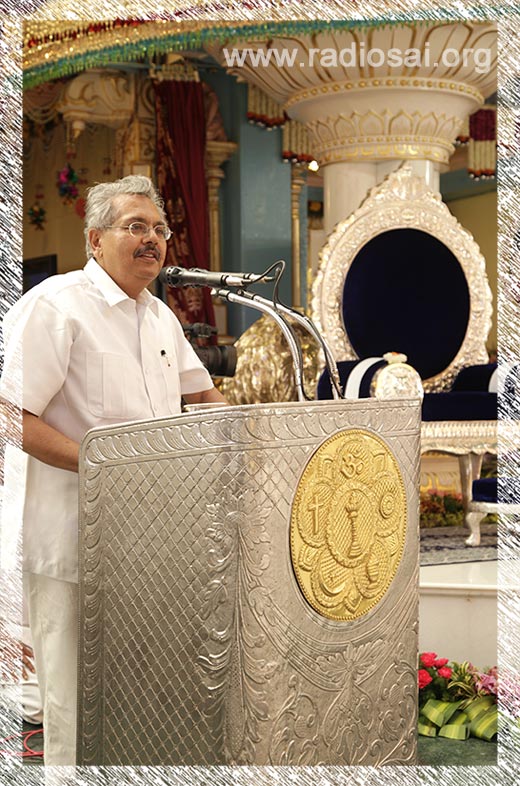 |
Coming back to the Trust, even the Easwaramma Trust was entirely Swami’s idea.
Nearly 10 years before He formed the Easwaramma Trust, He had said during one of the interviews, “I am going to form a Ladies Trust and you (referring to Mrs. Madhuri Naganand) are going to be there.” At that time, I had no clue what He was talking about.
KM: Mr. Naganand, you are a Trustee of the Media Foundation of which Radio Sai is a part. You also represented the Sai Organization in mainstream media when there was a frenzy of interest after the Maha Samadhi. What was it like to have the spotlight turned on the Trust and on Bhagawan all of a sudden after those decades of working with a certain degree of anonymity?
SSN: It was strange because very few knew of us - the people associated with the various organizational activities of the Trust. In my own professional set up, a number of people never knew that I was connected with the Sathya Sai Trust.
KM: Because you kept such a low profile?
SSN: That’s how everybody was, there was nothing like a profile for us because it was Swami, it was Swami’s work, Swami’s Trust and there was nothing else. If you see the news reports, if you see some of the publications - there was no other name but Swami’s. He was doing everything, we were just the instruments. He just wanted us to be sort of around and to allow people to think that we were getting things done when He was the one actually making things happen. The media was hardly interested in what was happening here till then. Unfortunately, this media glare started surfacing just before the Maha Samadhi. And you know how the media is – with no real regard for the truth, truth is not their agenda.
KM: They just prefer to sensationalize news, with no verification.
SSN: Put something out there so everyone will read it. The media drama went on for some time until after a point it got too much and I somehow persuaded the Trustees to intervene. Most of them were of the view that we should stay away. And I said, “Look all sorts of things are being said, it is time we come forward and tell them what the truth is and what exactly we are doing. It’s time that we started talking to the press, meeting them, giving them information and telling them look here you are making a claim like this, this is not correct.” I think I succeeded a bit in my argument and the Trustees realized and understood that it was necessary for us to meet, interact and provide authentic information to the media. Of course the media was very happy that we initiated an open conversation. They lapped up everything that we said and eventually lost interest in us. Thankfully, we have been out of the media glare for some time now. We continue doing what Swami has mandated us to do and we are doing it to the best of our abilities.
The sudden attention was somewhat unnerving. As completely unknown personalities who were always in the shadow, we were not used to such media glare. And, I think it ought to be always like that. Even today, I would like to say that we as individual Trustees should not be seen or perceived in public as that so-and-so person. It should really be Swami in the forefront and we as His foot soldiers, we are here to do a particular task. As long as Swami was here with us in His physical Form, He was doing everything. We had a Council of Management of which I was a part of for so many years but we were not doing anything because He was doing everything. Now that responsibility has fallen on the Trust as a whole – the Board of Trustees. Even now Swami inspires all of us to do things, Swami is ensuring that things are going on as per His wishes. And, if we face media challenges or any other challenges for that matter, it is only Swami’s way of testing us to see how we react.
All we need to do is keep our head on our shoulders, keep our eyes trained on the path that we are treading, and forget about ourselves personally. And, most of us are indeed like that. Our demeanor should be such that we reduce the ego. The role of the Trustee is a responsible position, it’s not to be done in public glare, we know what the mandate is – we just need to do our job quietly and inspire people. We are here to ensure that the large body of Swami’s devotees is happy, make sure that we provide them with the amenities and facilities when they come to Parthi. The rest of the work is done by Swami – He is there to take care of His mission.
KM: Are you satisfied with the way things are progressing?
SSN: Yes. The Board of Trustees is fully committed in their participation and the ashram activities are going on in full swing. I love the way in which the students are looking after the mandir programmes, each and every programme has been exceptional, full of devotion, full of Swami’s message. Except for missing the physical form of Bhagawan walking in and walking out and giving us the pleasure of His darshan, I think the atmosphere of the ashram is maintained in a wonderful way. And, for this all credit should go to the students, the University, the teaching staff and of course the large body of devotees who continue to come and participate in the daily programme with rapt attention.
KM: Mr. Naganand, you are a successful lawyer and you have so many professional commitments. How do you find the time and mind space to devote yourself both to Sai work, your family and your professional commitments. How do you strike that balance?
SSN: I’ll answer this question with a small story that happened just before Swami’s Maha Samadhi. We always used to have a meeting of the Trust on the weekends, usually on a Sunday because Swami knew that I was busy during the week. Mr. Giri used to be in touch with me about the dates and schedules and he confirmed the meeting for that Sunday. However, on Saturday morning Mr. Giri called me to say, “Swami has asked for the meeting today - Saturday at 4 o’clock.” I was immediately worried about how I would ever make it. I told Mr. Giri that we were in the middle of a big trial, and I would be cross-examining the witness that day. The judge had also warned me the previous day that unless I finished the cross examination of this witness, he would not allow me to leave. Most of the subordinate court judges know that the High Court does not function on Saturdays, so I couldn’t even give the excuse of High Court to the judge and I had to show up. So when Mr. Giri rescheduled the meeting for Saturday, I didn’t know what I would do. Anyway, I went to court, the case went on, and at about 1.30pm or 1.45pm, the phone buzzed in my pocket. I couldn’t take the call because witness was still being cross examined. But, in the most bizarre turn of events, within ten minutes the judge just picked up the papers, dropped them on the table and said, “Call the next case, witness is discharged.”
I was confused for a moment and asked the junior what had happened and why the judge just closed the proceedings. He said, “I don’t know Sir, all of a sudden she just said she’s not continuing with your case and she has discharged the witness and asked you to take a date and go.” Relieved, I stepped outside, took out my phone and saw a missed call from Mr. Giri. I called him immediately, and he said, “Naganand, Swami has just confirmed the meeting at 4 o’clock, can you make it? You have to make it.” I rushed home, had a quick lunch, and drove straight back.
I was at Yajur Mandir exactly at 4 o’clock. The point is when you are doing Swami’s work, He takes care of everything, you really should not worry about how you will accomplish a task. If you have the devotion and the dedication to do Swami’s work, everything else is taken care of. I have experienced this countless times.
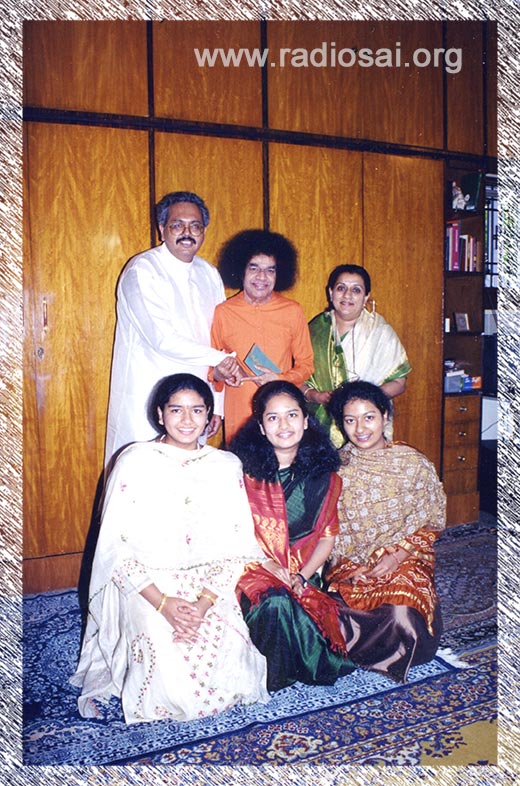 | |
With the entire family during a visit to their home in Bangalore, 2 Jun 2000
|
KM: Swami used to joke about your profession, saying lawyers are liars. Were you amused by that?
SSN: Yes of course! Although Swami would say that in jest, he took much pride in introducing me to everyone. Several times, in a big interview group, he would suddenly look at me and tell them, “You know who he is?” And all eyes would be on me. Then, Swami would say, “He’s my lawyer.”
He has said it so many times. When referring to lawyers, Swami might have echoed the popular belief that lawyers are liars but at a personal level He was always very, very affectionate. And He took pride in introducing me to His close confidants. Not just me, He would introduce Mr. Giri saying, “You know who he is? Chief Vigilance Commissioner.” About Mr. Bhagwat, he would say,
“You know who he is? He is World Bank.” He would say that because Mr. Bhagwat was a senior advisor in the World Bank. Swami took great pride in the people around Him.
KM: Mr. Naganand, as a person who deals with mainstream issues across the country, do you really think it is possible to practice Swami’s five human values in today’s India - where corruption and dysfunctional systems are so rampant?
SSN: The choice has to be made, and in my own personal life I have found it possible to stand by the truth even in difficult situations. I have several clients telling me, “Sir what is being done is very unfair, we should also use unfair means.” I always tell them that if you do one unjust thing or use unfair means, it will lead to another. So even if it causes you loss, it is better to stand by the truth for truth is a complete answer to everything. To find out what is dharma, we need not go around asking people. We just have to touch our hearts and ask the question and you know where the answer lies. I agree that in those extremely crucial situations when nothing seems to go according to plan and you know corruption is all around you, it’s always a temptation to take the easy route. But it is up to us to be strong and look at the larger picture.
A dear friend of mine who is also a great devotee of Bhagawan has undergone a lot of trials and tribulations. When he seeks my advice, I tell him the same thing. I met him recently and he said, “Sir I have been following your advice but my problems are not over.” But because he is such a staunch believer of Bhagawan, he also says that the problems are being given to him by Swami to make him into a better human being and be of greater service to others. To his credit, this friend has done fantastic service for Swami’s Trust but he is still undergoing difficulty. It is commendable how he continues to stand by the right path. http://media.radiosai.org/journals/vol_12/01SEPT14/A-Deep-&-Divine-Devi-Connection-part-02.htm


Комментариев нет:
Отправить комментарий